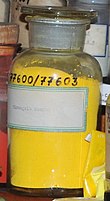
| |

| |
| Names | |
|---|---|
| Other names
see text
| |
| Identifiers | |
| ChEBI | |
| ECHA InfoCard | 100.028.951 |
| EC Number |
|
PubChem CID
|
|
| RTECS number |
|
| UNII | |
| UN number | 3288 |
CompTox Dashboard (EPA)
|
|
| Properties | |
| PbCrO4 | |
| Molar mass | 323.192 g/mol |
| Appearance | bright yellow powder |
| Density | 6.12 g/cm3, solid |
| 0.00001720 g/100 mL (20 °C)[1] | |
| Solubility | soluble in diluted nitric acid insoluble in acetic acid, ammonia |
| −18.0·10−6 cm3/mol | |
Refractive index (nD)
|
2.31 |
| Structure | |
| monoclinic | |
| Hazards | |
| Occupational safety and health (OHS/OSH): | |
Main hazards
|
Carcinogen and moderately toxic |
| GHS labelling: | |
 
| |
| Danger | |
| H350, H360, H373, H410 | |
| P201, P273, P308+P313, P501 | |
| NFPA 704 (fire diamond) | |
| Lethal dose or concentration (LD, LC): | |
LD50 (median dose)
|
>12 g/kg (mouse, oral) |
| Safety data sheet (SDS) | ICSC 0003 Sigma-Aldrich |
Except where otherwise noted, data are given for materials in their standard state (at 25 °C [77 °F], 100 kPa).
| |
Lead(II) chromate is an inorganic compound with the chemical formula PbCrO4. It is a bright yellow solid that is very poorly soluble in water. It occurs also as the mineral crocoite. It is used as a pigment.
- ^ Lide, David R., ed. (2006). CRC Handbook of Chemistry and Physics (87th ed.). Boca Raton, FL: CRC Press. ISBN 0-8493-0487-3.
